NASA's Hubble Spots Spectacular Supernova From 11 Billion Years Ago
Thanks to a cosmic magic trick, the Hubble Space Telescope witnesses three different moments in a star's explosive death process.
A supernova is a spectacular example of a star going out with a bang and not a whimper.
The Hubble Space Telescope captured an unprecedented view of a supernova's explosive death process from 11 billion years ago. That places the event deep into the past of our 13.8-billion-year-old universe. "This is the first detailed look at a supernova so early in the universe's history," NASA said in a statement Wednesday.
Hubble, a joint project of NASA and the European Space Agency, remarkably saw the supernova three times in one observation thanks to a phenomenon called gravitational lensing. Galaxies can act as cosmic magnifying glasses that allow Hubble to see distant objects, like the supernova. In this case, a galaxy cluster named Abell 370 worked like a group of magnifying glasses, letting scientists trace the supernova's evolution over multiple days.
Annotated images show galaxy cluster Abell 370 (left) that magnified the supernova's different stages. The four images on the right show variations on Hubble's supernova view with days zero, two and eight marked.
What Hubble captured was more like a time-lapse. "A clue is that the cooling supernova fireball appears in slightly different colors among the supernova images," NASA said. "The images arrived at different times because length of the pathways the supernova light followed is different. The later images were delayed due to taking a longer route across 'valleys' of warped space."
Postdoctoral researcher Wenlei Chen at the University of Minnesota is the first author of a paper on the Hubble discovery published this week in the journal Nature. "It is quite rare that a supernova can be detected at a very early stage, because that stage is really short," said Chen.
The Hubble images show the supernova on day zero, day two and day eight. It appears blue (indicating hotter temperatures) early on and then fades to red (indicating cooler temperatures). "You've got the massive star, the core collapses, it produces a shock, it heats up, and then you're seeing it cool over a week," said study lead Patrick Kelly. "I think that's probably one of the most amazing things I've ever seen!"
The astronomy team calculated the size of the supernova based on its brightness and rate of cooling, pegging it at about 500 times larger than our sun. The massive star was a red supergiant. Betelgeuse, known for its odd dimming behavior, is a famous example of a red supergiant.
The researchers excavated the supernova observation from Hubble's extensive data archive. The telescope has been in space for over 30 years and is actively sending back new discoveries. This study shows there are still treasures to be found hidden away in Hubble's past body of work.


